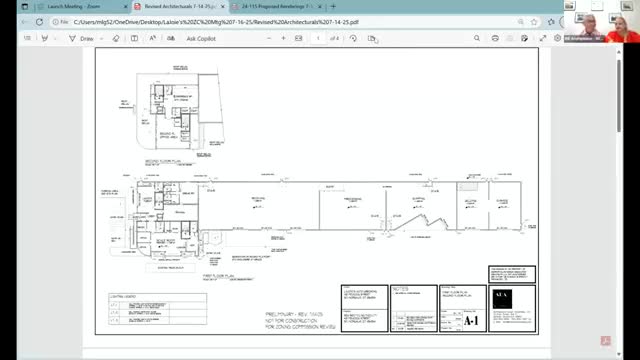City Commission reviews new metal recycling facility plans and safety measures
July 25, 2025 | Norwalk City, Fairfield, Connecticut
This article was created by AI summarizing key points discussed. AI makes mistakes, so for full details and context, please refer to the video of the full meeting. Please report any errors so we can fix them. Report an error »

In the heart of Norwalk City, the Planning and Zoning Commission convened to discuss a significant proposal that could reshape the local industrial landscape. As the meeting unfolded, the focus turned to a new recycling facility, sparking a blend of curiosity and concern among commissioners and community members alike.
The proposal, which involves the construction of a hybrid facility combining two buildings, aims to enhance the efficiency of metal recycling operations. The facility is designed with safety and environmental considerations at its core, featuring elevated floor levels to comply with flood regulations and a layout that minimizes potential hazards. The administration building will rise two stories, while the processing area will be housed in a high bay structure, ensuring that operations remain efficient and secure.
A key point of discussion was the facility's environmental impact, particularly regarding air quality. Commissioners raised questions about potential toxic fumes and airborne debris from the recycling process. Representatives assured the commission that the operations would be conducted indoors, significantly reducing the risk of harmful emissions. They emphasized that the facility would not handle materials known to produce volatile organic compounds (VOCs) or other noxious odors, aiming to maintain a safe environment for nearby residents and businesses.
Visual aids played a crucial role in the meeting, with detailed renderings of the proposed facility shared with attendees. These images showcased a modern design featuring clear glass for natural light and an inviting aesthetic, complemented by iron fencing and landscaped entryways. The intention is to create a facility that not only serves its industrial purpose but also enhances the visual appeal of the area.
As the meeting progressed, the commission expressed a desire for further clarification on safety measures and operational practices. The owners of the facility were invited to provide additional insights, ensuring that all concerns were addressed comprehensively. This collaborative approach reflects the commission's commitment to transparency and community engagement.
The discussions at this meeting highlight the delicate balance between industrial development and community well-being. As Norwalk City continues to evolve, the outcomes of such proposals will play a pivotal role in shaping the future of its neighborhoods and the quality of life for its residents. The commission's ongoing deliberations will determine how best to integrate new facilities while safeguarding the interests of the community.
The proposal, which involves the construction of a hybrid facility combining two buildings, aims to enhance the efficiency of metal recycling operations. The facility is designed with safety and environmental considerations at its core, featuring elevated floor levels to comply with flood regulations and a layout that minimizes potential hazards. The administration building will rise two stories, while the processing area will be housed in a high bay structure, ensuring that operations remain efficient and secure.
A key point of discussion was the facility's environmental impact, particularly regarding air quality. Commissioners raised questions about potential toxic fumes and airborne debris from the recycling process. Representatives assured the commission that the operations would be conducted indoors, significantly reducing the risk of harmful emissions. They emphasized that the facility would not handle materials known to produce volatile organic compounds (VOCs) or other noxious odors, aiming to maintain a safe environment for nearby residents and businesses.
Visual aids played a crucial role in the meeting, with detailed renderings of the proposed facility shared with attendees. These images showcased a modern design featuring clear glass for natural light and an inviting aesthetic, complemented by iron fencing and landscaped entryways. The intention is to create a facility that not only serves its industrial purpose but also enhances the visual appeal of the area.
As the meeting progressed, the commission expressed a desire for further clarification on safety measures and operational practices. The owners of the facility were invited to provide additional insights, ensuring that all concerns were addressed comprehensively. This collaborative approach reflects the commission's commitment to transparency and community engagement.
The discussions at this meeting highlight the delicate balance between industrial development and community well-being. As Norwalk City continues to evolve, the outcomes of such proposals will play a pivotal role in shaping the future of its neighborhoods and the quality of life for its residents. The commission's ongoing deliberations will determine how best to integrate new facilities while safeguarding the interests of the community.
View full meeting
This article is based on a recent meeting—watch the full video and explore the complete transcript for deeper insights into the discussion.
View full meeting
